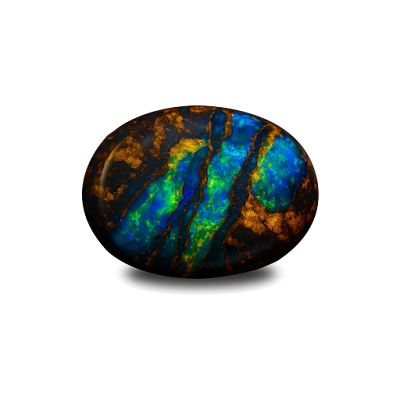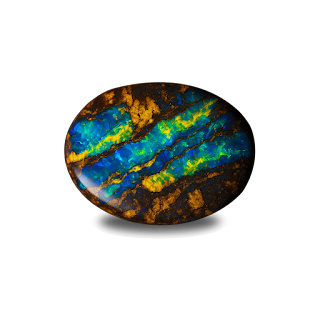In the vast tapestry of gemstones, Boulder Opal emerges as a masterpiece where raw earth meets celestial light. Unlike any other gem, it captivates with its dramatic contrast-a rugged ironstone matrix cradling flashes of iridescent color. Originating from the ancient landscapes of Australia, Boulder Opal is a storyteller, weaving tales of geological wonder, cultural reverence, and artistic inspiration. This gem isn’t just worn; it’s experienced, offering a slice of the Outback’s soul in every unique fragment.
Formation: A Dance of Elements
Boulder Opal’s genesis begins over millions of years in the arid heart of Australia. Here, silica-rich water seeps into cracks and cavities of ironstone boulders, left behind by retreating ancient seas. As the silica settles, it hardens into opal, intertwining with the host rock. This union creates striking veins or layers of opal, often thin but vibrant, set against the ironstone’s deep hues. The result is a natural mosaic, where each piece tells a story of patience-nature’s artistry forged under extreme pressure and time.
Geography: Australia’s Treasure
Queensland’s remote regions, particularly around towns like Winton, Quilpie, and Koroit, are the epicenters of Boulder Opal mining. Miners brave harsh conditions to extract these gems, often following “opal dirt” traces in dry creek beds. The process is meticulous, requiring an eye for the subtle signs of opal beneath the ironstone’s surface. While minor deposits exist elsewhere, Australia’s Queensland remains the unrivaled source, producing 90% of the world’s supply.
Physical Characteristics: A Study in Contrast
Boulder Opal’s charm lies in its duality. The gem’s “play-of-color”-a spectrum of reds, blues, greens, and golds-shimmers against the ironstone’s somber backdrop. This effect arises from light diffracting through microscopic silica spheres within the opal. The stone’s hardness (5.5-6.5 on the Mohs scale) and the ironstone’s robustness make it more durable than other opals, though care is still needed. Each piece varies: some display bold color bars, while others feature delicate dendritic patterns or flecks of brilliance.
Historical and Cultural Roots: From Dreamtime to Modernity
For Indigenous Australians, Boulder Opal is imbued with spiritual significance. Aboriginal legends speak of a creator spirit who painted the land with rainbow hues, leaving fragments of this magic trapped in stone. These opals were used in rituals and as talismans for protection. European settlers later discovered them in the 1870s during Australia’s opal rush, sparking global fascination. Today, they symbolize a bridge between ancient traditions and contemporary design.
Jewelry and Design: Embracing Nature’s Imperfections
Jewelry designers cherish Boulder Opal for its organic aesthetic. Unlike precision-cut gems, it’s often shaped into freeform cabochons, preserving the ironstone’s natural edges. The stone’s raw beauty pairs elegantly with rustic metals like oxidized silver or textured gold. Notable pieces, such as the “Halley’s Comet” opal, showcase its grandeur. While commonly set in pendants or earrings to minimize wear, bold designers occasionally feature it in statement rings, celebrating its untamed spirit.
Care and Preservation: Honoring Fragility
Though hardy, Boulder Opal demands mindful care. Avoid exposure to chemicals, extreme temperatures, and ultrasonic cleaners. Its water content (5-10%) necessitates occasional hydration-store with a damp cloth to prevent cracking. Protective settings, like bezels, shield it from impacts. With proper care, these gems can transcend generations, their colors undimmed by time.
Metaphysical Realm: Earth and Ether
In metaphysical circles, Boulder Opal is revered as a harmonizer. The ironstone anchors spiritual energy, offering grounding, while the opal stimulates creativity and emotional release. It’s said to balance Yin-Yang energies, making it a favorite among healers. Though unscientific, these beliefs highlight humanity’s enduring quest to find meaning in nature’s wonders.
Market Dynamics: Rarity and Craftsmanship
Boulder Opal’s value hinges on color intensity, pattern rarity, and opal thickness. Red and orange hues command premium prices, with intricate “harlequin” patterns being highly sought. Prices range from $50 to thousands per carat, reflecting craftsmanship and origin. Ethical mining practices are increasingly prioritized, with traceability appealing to conscious consumers.
Conclusion: A Gem of Timeless Wonder
Boulder Opal is more than a gem-it’s a testament to Earth’s alchemy. Its interplay of light and stone captivates collectors, historians, and dreamers alike. Whether admired for its beauty, cultural depth, or mystical allure, Boulder Opal invites us to pause and marvel at nature’s ability to transform ordinary elements into extraordinary art. In a world of mass-produced luxuries, it remains a symbol of authenticity, each piece a unique echo of the ancient land it calls home.














0 Comments